You may be reading this and think it’s silly for cats to be stressed. What would cats have to be stressed about anyway?
As it turns out, cats are very easily stressed! And stress can lead to serious behavior and health problems down the road.
You might not even be aware your cat is stressed.
Keep reading to identify the signs of cat stress and learn how to help your cat live a more stress-free life!
Do Cats Get Stressed Out?
Contrary to popular belief, cats are very prone to stress and anxiety.
However, humans and cats experience stress very differently.
So, unless you’re an experienced cat owner or cat behaviorist, you probably can’t identify when your cat is stressed.
This is why you need to follow specific steps to understand why your cat is stressed and how to resolve the problem that’s causing their stress.
Why Do Cats Get Stressed?
Cats are naturally anxious creatures.
In the wild, a healthy amount of stress is important for an animal’s survival.
However, too much stress can lead to serious health complications.
There are a number of things that can trigger unhealthy amounts of stress in cats:
- Guests
- Changes in living situation
- Addition of another pet
- Lack of space
- Overstimulation
- Boredom
- Visiting the vet
- Competing for resources
- A dirty litter box
- General inconsistencies
This does not mean every time your cat gets bored, they face dire consequences.
But, a combination of these factors could be detrimental to your cat’s health.
Why Is Stress Bad For Cats?
Too much stress can lead to a number of complications.
Some of the signs of stress are so small that you might not even notice them.
But, it’s important to know what the signs and consequences look like:
- Vomiting
- Loss of energy
- Changes in appetite
- Weight loss or gain
- Over-grooming or pulling out fur
- Urinating or defecating (pooping) in places other than the litter box
In addition to these, stress can account for overall changes in your cat’s behavior.
They might begin excessively using scratching posts, or even scratching your furniture.
Beyond this, your cat might become overly aggressive with household members, both humans and other pets.
A stressed cat will also neglect their litter box and go to the bathroom in inappropriate parts of the house.
Stress can even lead to disease or infection.
For instance, many vets believe stress can lead to a urinary tract disease called Feline Idiopathic Cystitis (FIC).
At its worst, this disease can be life threatening.
Is Their Environment Peaceful or Stressful?
Whether you suspect or cat is stressed, or you’re trying to avoid that situation entirely, it’s important that you sweep your house for potential triggers.
Before you do this, there are a few important things to keep in mind.
There’s a big difference between your cat experiencing stress for an extended period of time and experiencing stress temporarily.
It’s normal for a cat to occasionally become stressed. However, you must provide them with ways to alleviate that stress.
There is often more than one factor contributing to your cat’s stress levels. So, don’t quit after you find just one cause.
Here are the biggest sources of stress and anxiety. Ask yourself the questions below to determine if/why your cat is stressed.
- Have you moved recently?
- Have you added a new pet or family member to your home?
- Have you changed your daily routine?
- Has there been a sudden change in your home?
If you answered yes to any of these questions, your cat will need both your assistance and an adjustment period to get used to the change in environment.
After you’ve considered the more obvious factors above, start looking at less noticeable things:
- House or neighborhood too noisy?
- Giving your cat too much or too little attention?
- Litter box neat and tidy?
- Having company too often?
- Multiple cats competing for food or water?
- Does your cat have enough personal space?
Look for all of the things that could potentially be stressing your cat out and make a list of them.
First: Go To The Vet
Any time you notice a change in your cat, you should always take him/her to a licensed veterinarian.
The vet should should be the first solution you consider. Sometimes signs of stress can be mistaken as much more serious diseases and illness that require immediate medical attention.
Before going to the vet, write down a list of potential stressors and symptoms so you’re ready to discuss them with your veterinarian.
Having detailed information is critical. This will allow your vet to make an accurate diagnosis to prevent your cat from suffering any longer.
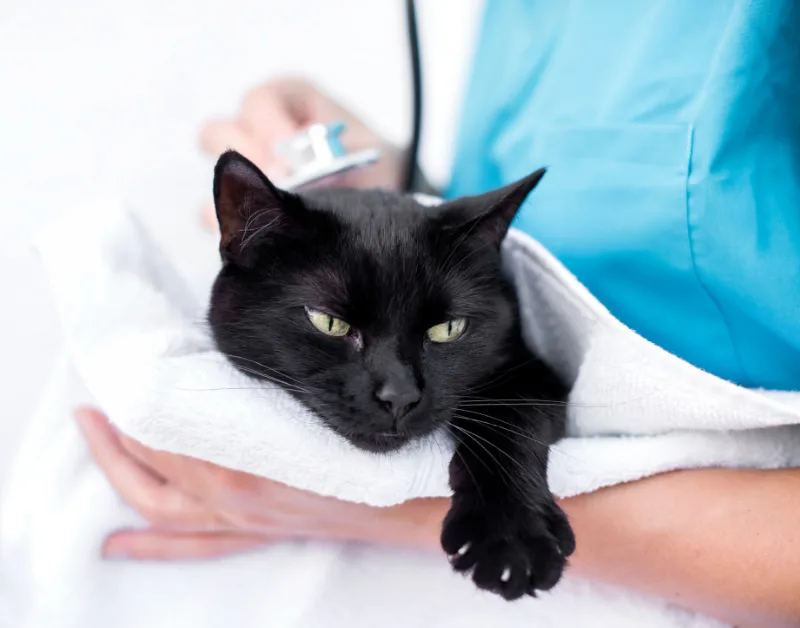
A veterinarian needs to see your cat in person to take vital signs and run diagnostic tests that will give you a better idea of what’s going on.
Veterinarians are professionals. They are the most qualified people to give you suggestions on minimizing your cat’s stress levels.
If your veterinarian gives your cat a clean bill of health, you can start exploring some of the stress relieving options below.
1. Pheromone Diffuser
The first and best strategy for managing your cat’s stress is to use a pheromone diffuser.
Cats release pheromones, or chemical communicators, to leave messages for other cats.
These pheromone messages could be used to convey anything from marking territory to calming or appeasing other cats.
You can think of pheromones as a cat’s own language.
Pheromone diffusers emit calming or appeasing pheromones to help cats be less stressed or aggressive.
This is considered one of the best options for reducing stress-induced behavior problems because of all the research that demonstrates its success.
The most popular pheromone diffuser that is used in research is the Feliway pheromone diffuser.

Several veterinarians use pheromone diffusers to help cats stay calm when entering the clinic.
Each cat is unique. What works for one cat may not work for another.
While these diffusers have been very successful for stress reduction, they might not be enough on their own.
Using pheromone diffusers in conjunction with the methods below will help tackle your cat’s stress from other angles.
2. CBD for Cats
Another solution involves the use of CBD, or cannabidiol.
CBD is a naturally occuring, non-psychoactive chemical compound that is extracted from industrial hemp.
Once extracted, it is ingested in the form of an oil or cooked into food.
Consuming CBD is reported to relax and calm individuals without inducing any sort of intoxication of altered mental state.
Many pet owners report CBD has been helpful in calming their pets down during a thunderstorm, road trip, or after moving houses.
In addition, pet owners have reported CBD has been helpful in alleviating their cat’s pain.
Ideally, CBD should be a temporary aid, not a permanent solution.
While research shows that CBD is safe for pets, you consult with your vet before purchasing a product.
If you choose to use CBD, make sure that you follow the instructions closely!
Give your cat the proper dose, and use it sparingly.
3. Create “Safe Spaces” for Your Cat
Sometimes, there’s nothing better than snuggling up under a pile of blankets after a long day.
Your cat probably feels the same way.
Cat’s love to be in tight, concealed spaces. This is their version of privacy or a “safe space”.
Cats are not good at conflict resolution. They must have somewhere they can escape to where they can be alone and unbothered.
When your cat nestles down in that small cardboard box, or squeezes themselves under the couch, they could be doing it for a few reason:
- Escaping overstimulation
- Observing environment secretly
- Regulating temperature
- Alone Time
- Security
While your kitty probably spends most of its time indoors, they still have their natural predatory instincts.
This instinct makes them want to see their environment without being seen themselves.
Without a space to satisfy this instinct, your cat will feel stressed.
Now that you understand why safe spaces are so important to cats, it’s time for you to learn how to create one (preferably, multiple).
Give your cat a few safe spaces where they can curl up tight without being seen.
This can be as simple as placing a couple boxes around corners of your house or areas of your home that are more quiet and not as busy.
The safe spaces don’t need to be completely inaccessable to others. They just need to be less occuppied by other members of your house.
For example, a laundry room or bathroom is perfect. Obviously people will enter these rooms, but not as often as places like the living room.
You might even want to invest in some more luxurious options, like cat cave or cozy cubby.


Just remember not to put your cat in a position they could become trapped. All safe spaces must have a clear exit.
RELATED: Why do cats love boxes and bags?
4. Perches
In addition to having places to curl up and get warm, cats also like to have a spot where they can perch up high and observe.
Similar to how cats will hide in order to see without being seen, perching on a raised surface allows the cat to observe its entire environment.
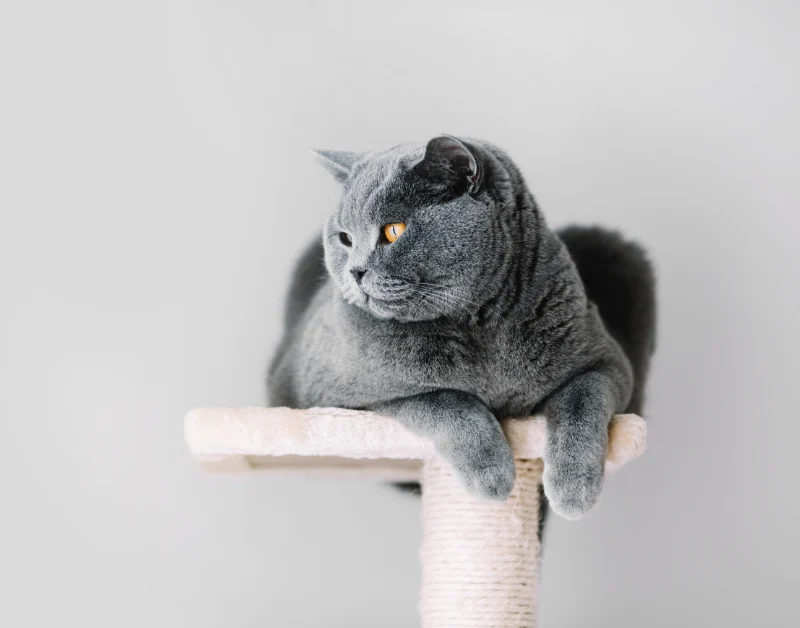
This also ties in with their predatory instincts.
When cats are at the highest point in the room, they can “hunt” freely without being surprised by anything above them.
This induces a feeling of security and control.
By being able to see the whole room without being seen themselves, your cat will feel more secure and less anxious.
Just be sure to have designated places your cat can perch, otherwise it will use your shelves and furniture.
Consider getting a cat tree or cat jungle. Then they can scratch and perch as much as they’d like!
5. Scratching Posts
Scratching posts are a key component to any cat living a healthy life.
They contribute to a number of things, a stress free environment being one of them!
Cats scratch things for a few reasons:
- Stress Relief
- Exercise
- Claw Maintenance
- Stretching
- Pheromone Communication
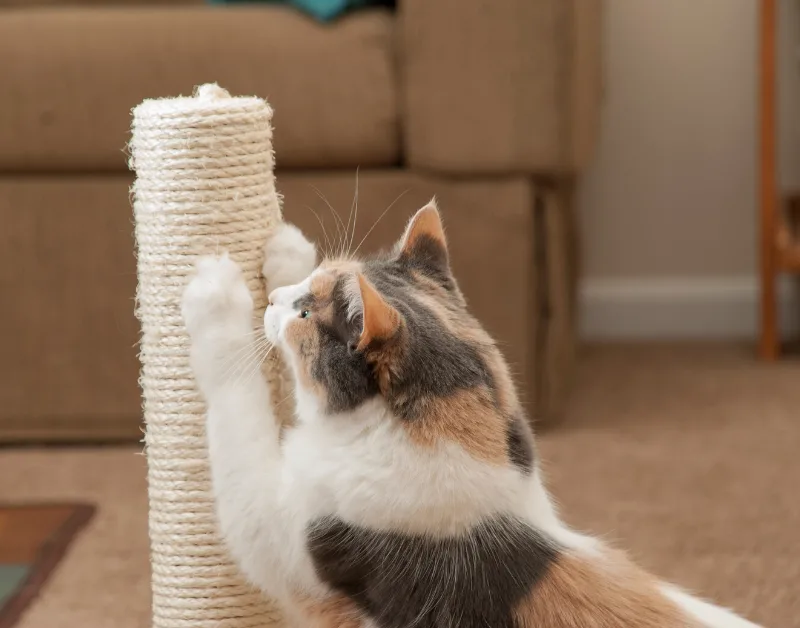
Not having a place to scratch will inhibit your cat from taking care of all of these things. This will cause stress!
Cats will often seek out places to scratch in order to relieve stress.
However, if they do not have enough variety of scratching posts, they might not get the desired relief.
RELATED: How To Choose The Best Scratching Post For Your Cat
Hopefully you’re noticing the cycle here: If they can’t scratch, they get stressed.
They can’t relieve themselves by scratching, so they get more stressed out!
So, they will seek out other things to scratch, like your furniture. More importantly, this could damage your cat’s health!
By providing your cat with the right scratching posts, you will give them a chance to relieve their stress on their own.
RELATED: 9 Easy Steps To Stop Your Cat From Scratching Furniture
6. Peaceful Mealtime
Having to compete for resources, especially food, will stress your cat out.
Any sort of insecurity related to food will result in an anxious cat, from timing to location.
This ties into everything you’ve already read concerning cats needing safe spaces and consistency.
Your kitty should feel at ease every time they eat.
Start by providing them with a safe, private area where they can eat their food alone.
If you live in a multi-cat or multi-pet household, it is strongly recommended that you feed each pet in a different part of the house.
This prevents the animals from becoming competitive and stressed as a result.
Feed each cat in same, designated place every time.
Cats are creatures of routine. Any deviation from the routine will make them anxious.
This is why it is very important that cats are fed at the exact same time everyday.
While your kitty can’t read a clock, they can definitely tell when they’re getting hungry.
So, if they find themselves more hungry than they usually are, they begin to think they may not get fed.
This insecurity leads to extreme stress and should be avoided at all costs.
To avoid this, simply give each of your cats their own place to eat, and set an alarm to make sure you feed them at the same exact time every day!
7. Clean and Private Litter Box
In addition to providing your cat with a safe space to eat, they should also have a private space to do their business.
This relates to cats needing to feel as secure as possible at all times.
Like most people, cats don’t like an audience when they’re using the restroom.
Cats feel vulnerable when they are using the litter box. The inability to comfortably relieve themselves will cause a tremendous amount of stress.
Making your cat’s litter box experience pleasant boils down to two things:
- Keep the litter box clean
- Keep the litter box private
- Have a litter box for each cat
Cats are territorial. This is why you should give each of your cats their own litter box that is placed in a private, comfortable area.
Yes, this means if you have three cats, you need three litter boxes.
Ideally, each litter box would be placed in a separate part of the house, but we know this is not always possible.
What’s most important is that there is a litter box for each cat.
Also, make sure their boxes are clean at all times. You should be scooping the litter box at least once or twice daily.
Ideally, you should get to it as soon as your cat uses it.
Are you a busy cat parent? Try an automatic litter box.

In addition to regularly scooping the litter box, you should replace all the litter in the box on a schedule depending on what kind of litter you have.
Replace the litter twice a week for non-clumping litter and once a month for clumping litter.
If you use a plastic litter box, you should replace the whole box once a year.
A tidy, private litter box will contribute to your cat’s overall wellbeing.
8. Let your Cat Look Outside
A bored cat is a stressed cat.
Providing them with toys, scratchers, and attention will help some, but they also need mental stimulation.
Cats are safer indoors, but this does not change their instinct to desire being outdoors.
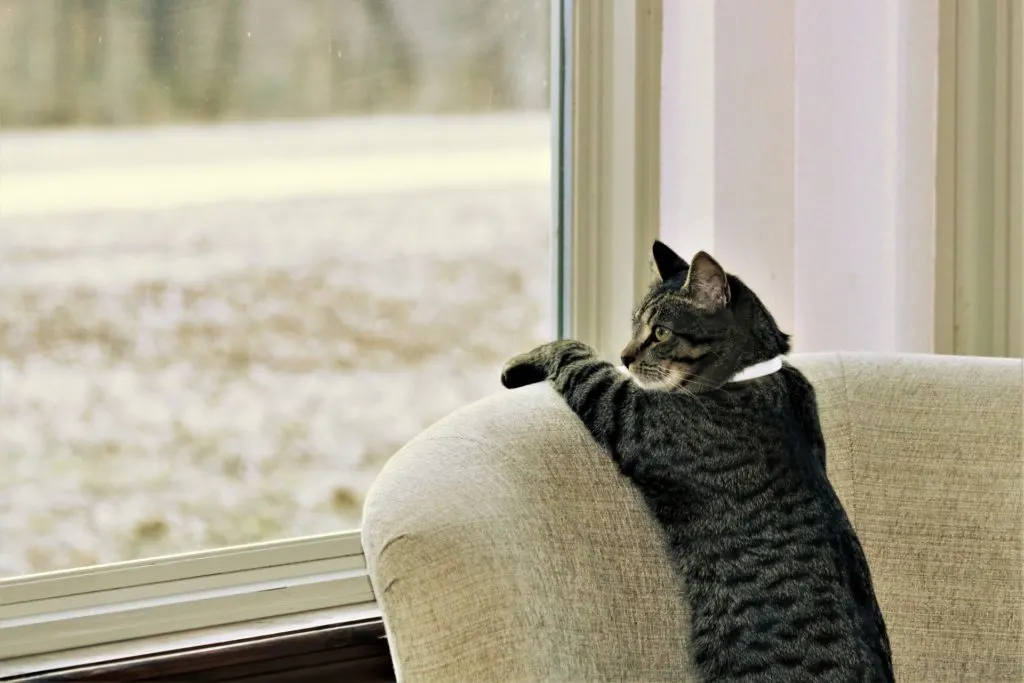
Compromise with your cat: set up a space where they can look out a window.
Better yet, give them multiple windows to look out of.
According to animal psychologist, Zazie Todd, windows are an important part of enriching an indoor cat’s envirionment.
This, in turn, will occupy your cats mind, giving them new things to look at every day.
A 2009 study conducted by Melissa Shyan-Norwalt, cat owners reported that their cats spent anywhere from 2-5 hours a day looking out the window.
Want to get creative? Let your cat try a window hammock!
This will act as both a perch and give a nice view of the outdoors.
9. Spend Quality Time With Your Cat
Giving your cat the right amount of attention will also help keep their stress levels in check.
Give them too little, and they’ll feel neglected; too much, and you will overwhelm them.
You need to let your cat know you love them and that they can trust you.
An important step in achieving this is understanding their boundaries.
Take some time to figure out when they like to snuggle or be pet: when they want attention and when they don’t.
Writers Note: “My cat likes to the most attention in the morning after he eats breakfast. This is when we spend the most quality time together.” – Josh
Once you figure out the times they usually seek attention, schedule that time for yourself as quality time with your little fur baby.
If you live with other people, you should also encourage them to do the same.
Your cat will be much less anxious if they feel loved by their owner.
10. Prescription Medicine
If you have tried all of the steps above consistently for at least 1 month and had your vet to check for underlying conditions, prescription medicine may an option.
This is typically seen as a last resort, but it is better than continuing to let your cat suffer from stress.
Consult with your veterinarian to see if prescription anti-anxiety medicine is a good option for your cat.
Conclusion
Helping your cat manage their stress will not only help your cat live a better quality life, but will also make you feed good knowing that you’re doing the best you can for your cat.
From just enjoying life to avoiding disease, your cat will benefit from a stress-free life.
Remember to take note of the signs of stress and always see your vet before making any conclusions of your own.
If you’ve been dealing with stress-induced behavior from your cat for a while, remember to be patient.
Use multiple stress relief methods. It will take time for your cat to be comfortable again.
Summary
By using these methods, you can potentially help your cat reduce its stress:
- Use a pheromone diffuser
- CBD
- Create a safe space for your cat
- Have tall places your cat can perch
- Create a safe space for your cat
- Consistent & peaceful meatimes
- Clean & private litter box
- Let them look out a window
- Spend quality time with your cat
- Prescription medicine from vet

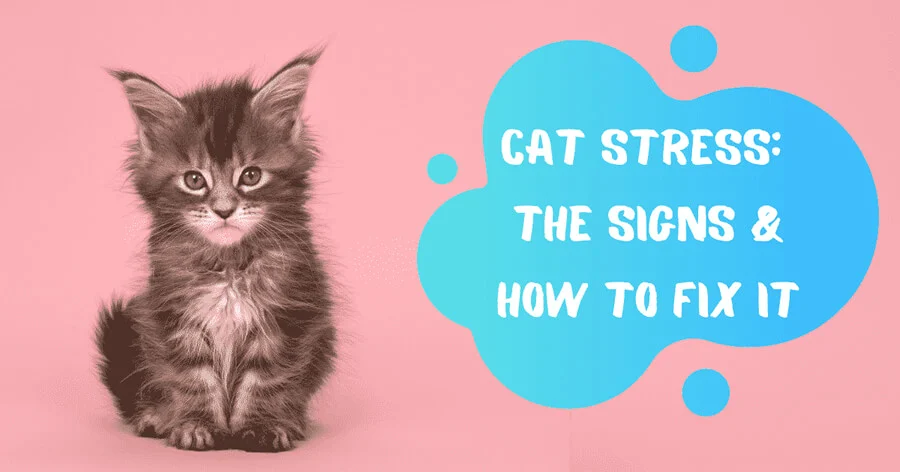


Rosemary Coyle
Thursday 16th of April 2020
My one cat would go after myself and other pets. I seemed to have solved the problem. I needed to show her more attention and also she her that she was special to me. I needed to give my 3 pets individual quality time.
Mary
Wednesday 15th of April 2020
Thank you for the info.
Matthew
Tuesday 14th of April 2020
Well written. Thank you for the insight.